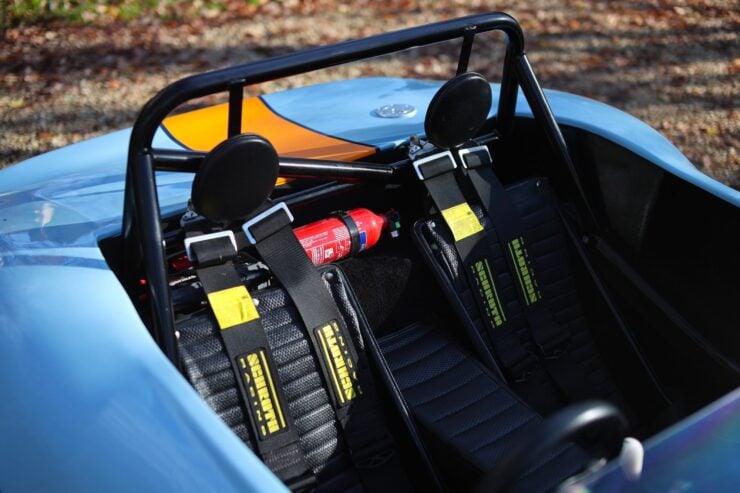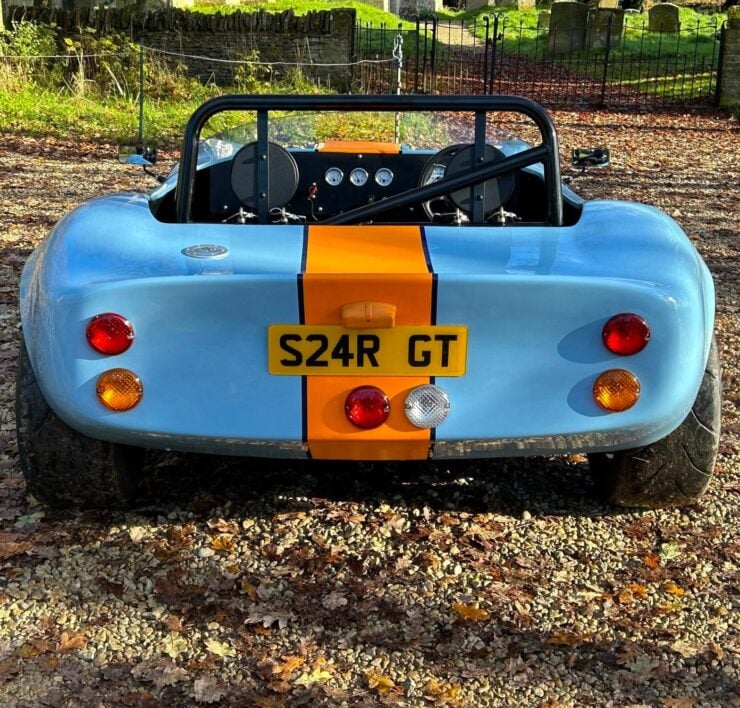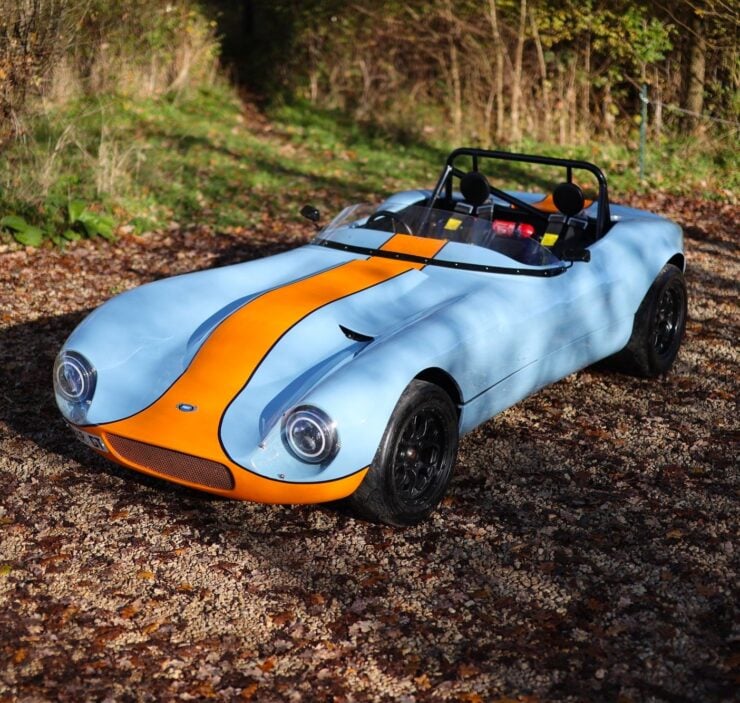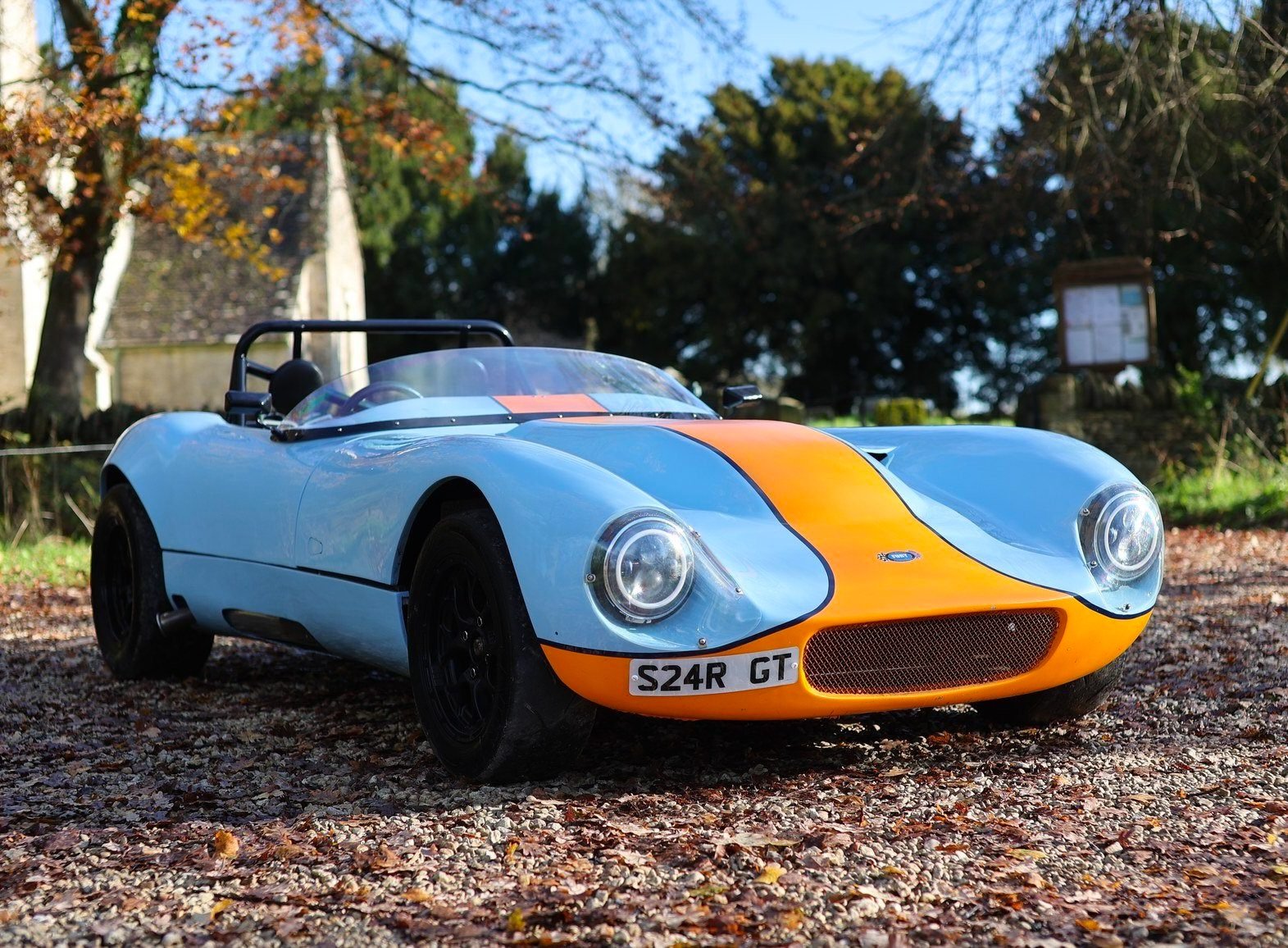This is a Fisher Fury from 2014. On a pound-for-pound basis it’s hard to argue that these aren’t some of the best lightweight sports cars in the world, with a curb weight of just 1,168 lbs (530 kgs) and 195 bhp on tap – that’s 334 bhp per ton.
The Fury has been in production since 1991 and it’s proven its ability time and time again, having been raced with much success in Britain and Europe in various championships and hillclimbs.
Fast Facts – The Fisher Fury
- The Fisher Fury, an unusual lightweight British sports car, boasts an impressive power-to-weight ratio and has been popular since its debut in 1991, with over 1,000 kits sold. Its fiberglass body, tubular steel chassis, and customizable engine options contribute to its racing success and affordability.
- Originating from the Sylva Fury by Jeremy Phillips, the design was sold to Mark Fisher in 1994, becoming the Fisher Fury. It features adaptable engineering, using parts from models like the Ford Sierra and Escort Mark II, and remains in production today by Fury Sportscars.
- Known for its versatility, the Fury has excelled in hill climbs, club racing championships, and local racing events, offering a low-cost entry point into motorsports. Its combination of sharp handling, excellent performance, and timeless styling has made it a favorite among sports car enthusiasts.
- The 2014 Fisher Fury Spyder shown in this article features a 195 bhp Ford Duratec engine, independent front and rear suspension, a 5-speed manual gearbox, and a Gulf Oil-inspired livery. It’s equipped with high-performance components like Jenvey throttle bodies and Omex500 ECU, making it one of the most refined examples of the model we’ve seen in recent memory.
The Great British Sports Car Recipe
Britain has long been home to a special breed of person who, against all odds, seems to be capable of designing and building world-class sports cars in their garage or garden shed. This is how many low-volume British automakers started out, including Lotus, TVR, Ginetta, Caterham, Marcos, Ariel, Noble, Brooke, and Fisher. Even Jaguar started out small, making motorcycle sidecars as the Swallow Sidecar Company.
Above Video: This clip from the British TV show Men and Motors features a young Richard Hammond interviewing Mark Fisher of Fisher Sportscars, about his vehicles and the backstory of the company.
The secret to the success of these low-volume sports car firms is a somewhat similar recipe. They develop exceedingly lightweight sports cars with sharp handling and class-leading power-to-weight ratios.
As it turns out, this recipe is the foundation of many (if not most) truly great sports cars. You just need to add in a good-looking body, seating for two, some luggage space if you feel like it, and off you go.
The Fisher Fury is one such car, and it can trace its lineage back to 1981 when Jeremy Phillips established his company Sylva Autokits in England. He quickly became one of the most prolific kit car designers in the country, designing 15+ vehicles and counting.
Phillips’ cars include the Star, Leader, the Striker MkI, Striker MkII, Striker MkIII, Striker Clubman, Phoenix, Fury, Stylus, Jester, Mojo 1 and Mojo 2, R1ot, R1ot SE, and the J15.
The Origins Of The Fisher Fury
The Sylva Fury debuted in 1991 and proved immediately popular thanks to its classic, timeless styling and the fact that it could be built to a high level on a tight budget. Phillips sold the design including the rights and all tooling to Fisher Sportscars in 1994, founded by Mark Fisher who continued to develop the design.


Now called the Fisher Fury, the car could be built with a wide variety of engine options, from Rover V8s to standard four-cylinder engines, right the way through to superbike engines which offer blisteringly high RPMs and sequential gearboxes.
The Fury has a tubular steel spaceframe chassis with a front-mounted engine and seating for two. All versions of the car had independent front suspension, however both live axle and independent rear suspension versions have been offered.
The body is made from lightweight fiberglass, and the central tub around the driver and passenger is largely made from aluminum sheet which is riveted to the chassis for additional rigidity.
Early versions of the kit could use Escort Mark II parts in the build, including the axle, gearbox, and engine. Later cars offered an independent rear end courtesy of donated parts from a Ford Sierra.
Many examples of the Fury have been built and raced with great success winning races and championships and increasing the brand awareness around the Fury in the process.
The cars are particularly popular in hillclimbs and local sports car racing events, and the fact that they can be built and maintained inexpensively has opened up the world of motorsport to many who otherwise may not be able to afford it.


Over 1,000 kits have now been sold, that’s including the earlier Sylva Fury and the later Fisher Fury designs. The car remains in production today by Fury Sportscars and they’re currently taking orders.
The 2014 Fisher Fury Spyder Shown Here
The car you see here is a Fisher Fury Spyder from 2014. It’s one of the best-sorted examples of the model we’ve seen in recent memory, as it comes with independent front and rear suspension, a 195 bhp Ford Duratec 2.0 liter four-cylinder engine, and fully adjustable front and rear suspension.
It’s finished in a discreet Gulf Oil-style livery of Blue with an Orange stripe down the center, and it has a Black interior with minimal distractions and a MOMO steering wheel.
Power is sent back through a heavy-duty clutch and a 5-speed BGH manual gearbox to an aluminum 3.9 LSD. It has Fisher lightweight driveshafts, a stainless exhaust with a sports catalytic converter, Jenvey throttle bodies, and an Omex500 ECU with software and a cable included.


The full list of specifications is impressive, and it’s clear that whoever built it originally essentially ticked every performance-oriented box on the order sheet, and then some.
The car is now being offered for sale out of Oxfordshire in United Kingdom on Car & Classic. If you’d like to read more about it or register to bid you can visit the listing here.

















Images courtesy of Car & Classic








